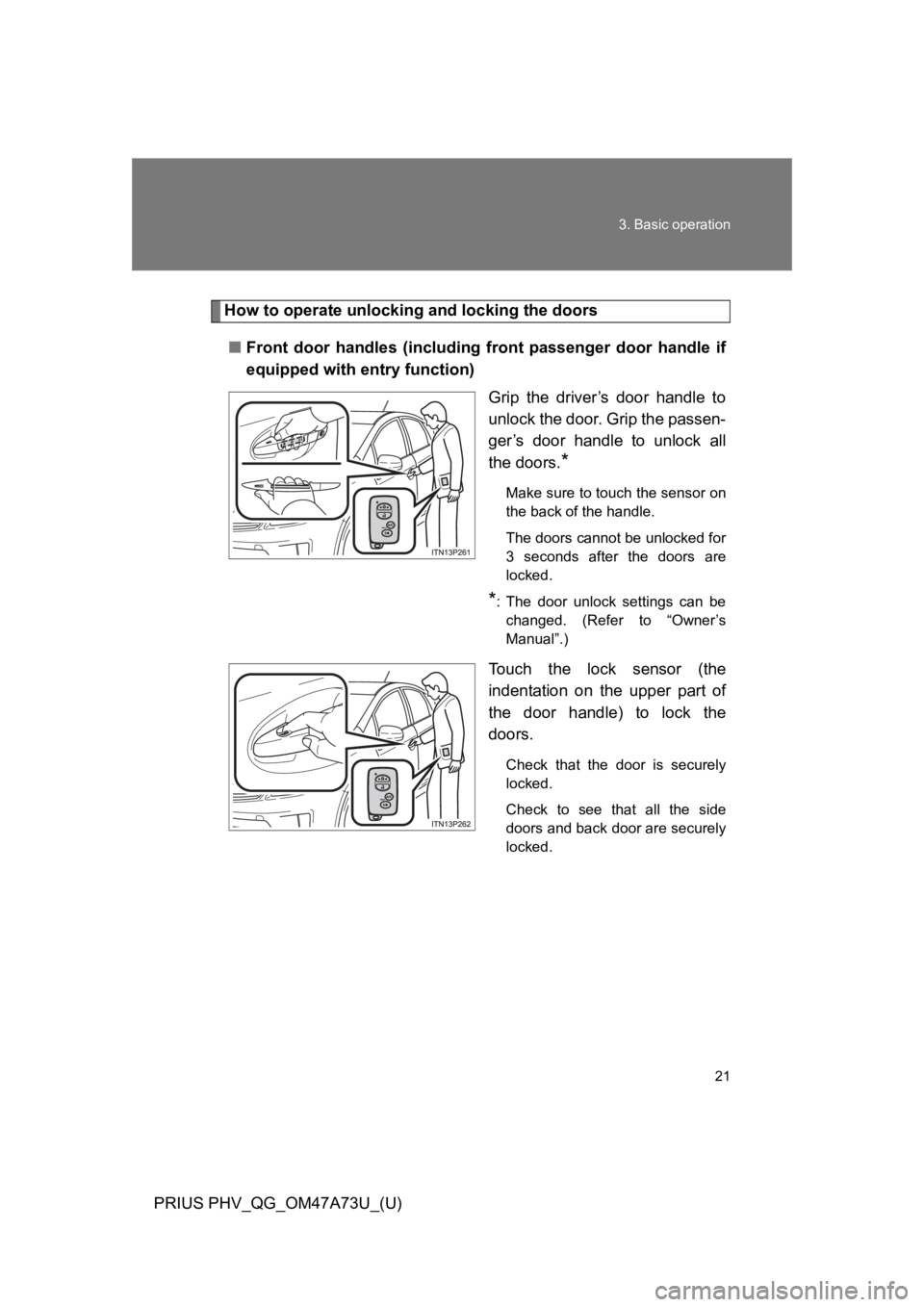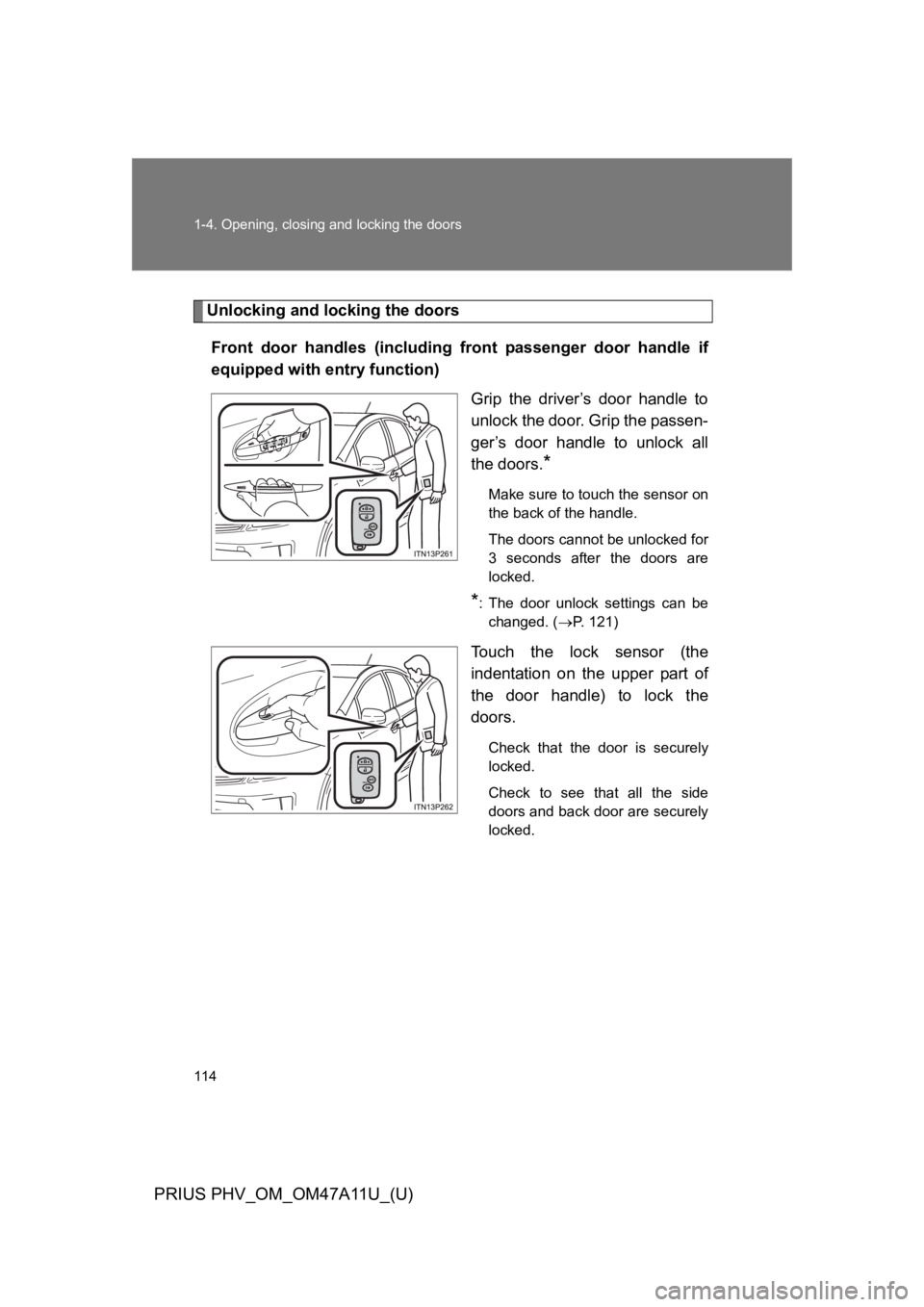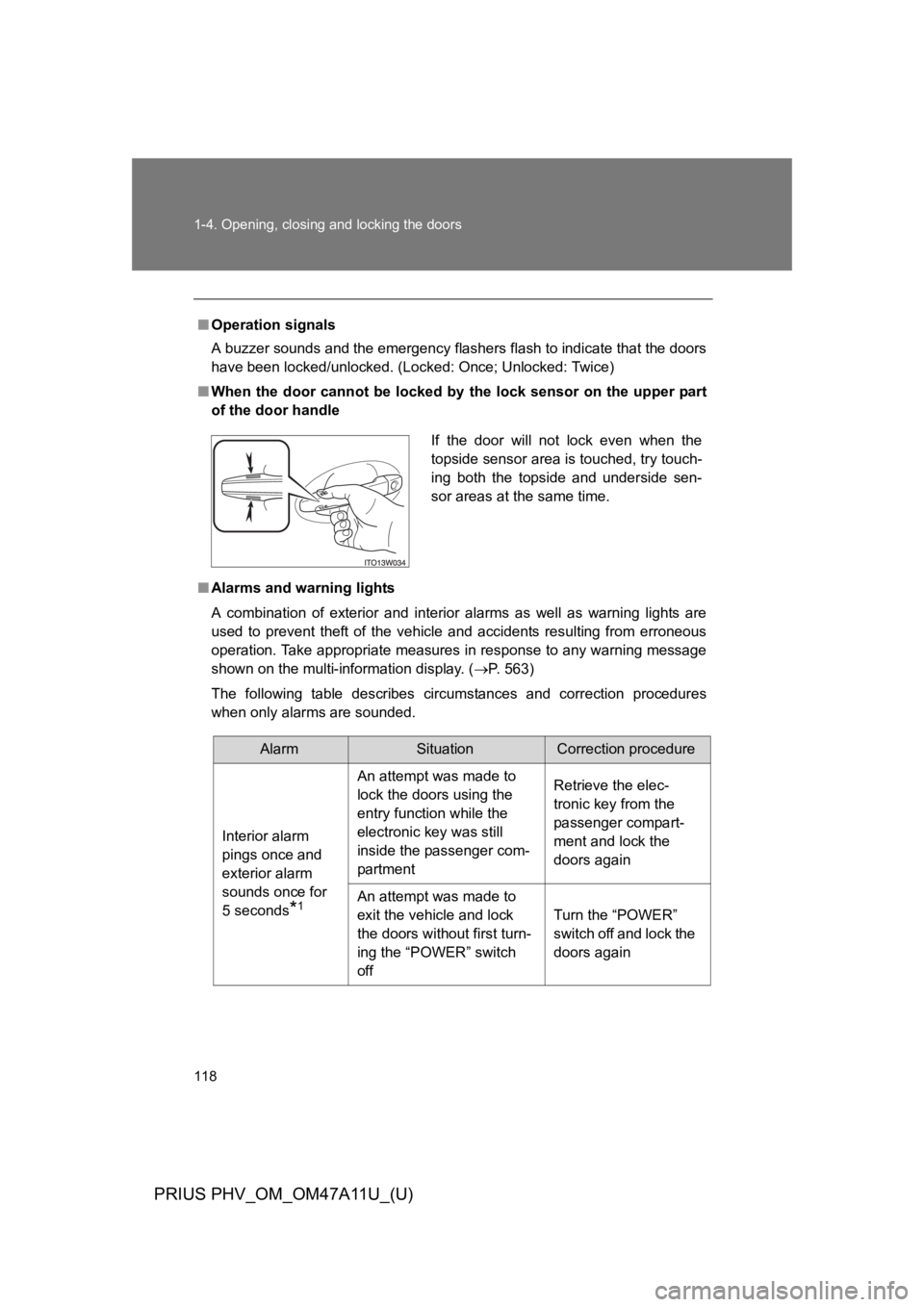sensor TOYOTA PRIUS PLUG-IN 2015 Owners Manual
[x] Cancel search | Manufacturer: TOYOTA, Model Year: 2015, Model line: PRIUS PLUG-IN, Model: TOYOTA PRIUS PLUG-IN 2015Pages: 728, PDF Size: 20.85 MB
Page 37 of 728

21
3. Basic operation
PRIUS PHV_QG_OM47A73U_(U)
How to operate unlocking and locking the doors
■Front door handles (including front passenger door handle if
equipped with entry function)
Grip the driver’s door handle to
unlock the door. Grip the passen-
ger’s door handle to unlock all
the doors.*
Make sure to touch the sensor on
the back of the handle.
The doors cannot be unlocked for
3 seconds after the doors are
locked.
*:The door unlock settings can be
changed. (Refer to “Owner’s
Manual”.)
To u c h t h e l o c k s e n s o r ( t h e
indentation on the upper part of
the door handle) to lock the
doors.
Check that the door is securely
locked.
Check to see that all the side
doors and back door are securely
locked.
Page 88 of 728

45
1-1. Plug-in hybrid system
1
Before driving
PRIUS PHV_OM_OM47A11U_(U)
Hybrid battery (traction battery) air vents
There are air intake vents on the
side of the rear right seatback
and on the front corner of the left
rear seat cushion for the purpose
of cooling the hybrid battery
(traction battery). If the vents
become blocked, the hybrid bat-
tery (traction battery) may over-
heat, leading to a reduction in
hybrid battery (traction battery)
output.
Emergency shut off system
When a certain level of impact is detected by the impact sensor, the
emergency shut off system blocks off the high voltage current and
stops the fuel pump to minimize the risk of electrocution and fuel
leakage. If the emergency shut off system activates, your vehicle will
not restart. To restart the hybrid system, contact your Toyota dealer.
Page 157 of 728

114
1-4. Opening, closing and locking the doors
PRIUS PHV_OM_OM47A11U_(U)
Unlocking and locking the doors
Front door handles (including front passenger door handle if
equipped with entry function)
Grip the driver’s door handle to
unlock the door. Grip the passen-
ger’s door handle to unlock all
the doors.*
Make sure to touch the sensor on
the back of the handle.
The doors cannot be unlocked for
3 seconds after the doors are
locked.
*:The door unlock settings can be
changed. (�oP. 1 2 1 )
To u c h t h e l o c k s e n s o r ( t h e
indentation on the upper part of
the door handle) to lock the
doors.
Check that the door is securely
locked.
Check to see that all the side
doors and back door are securely
locked.
Page 161 of 728

118
1-4. Opening, closing and locking the doors
PRIUS PHV_OM_OM47A11U_(U)
■Operation signals
A buzzer sounds and the emergency flashers flash to indicate that the doors
have been locked/unlocked. (Locked: Once; Unlocked: Twice)
■When the door cannot be locked by the lock sensor on the upper part
of the door handle
■Alarms and warning lights
A combination of exterior and interior alarms as well as warning lights are
used to prevent theft of the vehicle and accidents resulting from erroneous
operation. Take appropriate measures in response to any warning message
shown on the multi-information display. (�oP. 5 6 3 )
The following table describes circumstances and correction procedures
when only alarms are sounded.
If the door will not lock even when the
topside sensor area is touched, try touch-
ing both the topside and underside sen-
sor areas at the same time.
AlarmSituationCorrection procedure
Interior alarm
pings once and
exterior alarm
sounds once for
5 seconds*1
An attempt was made to
lock the doors using the
entry function while the
electronic key was still
inside the passenger com-
partment
Retrieve the elec-
tronic key from the
passenger compart-
ment and lock the
doors again
An attempt was made to
exit the vehicle and lock
the doors without first turn-
ing the “POWER” switch
off
Turn the “POWER”
switch off and lock the
doors again
Page 168 of 728

125
1-4. Opening, closing and locking the doors
1
Before driving
PRIUS PHV_OM_OM47A11U_(U)
■Note for locking the doors
●To u c h i n g t h e d o o r l o c k s e n s o r w h i l e w e a r i n g g l o v e s m a y d e l a y o r p r e v e n t
lock operation. Remove the gloves and touch the lock sensor again.
●When the lock operation is performed using the lock sensor, recognition
signals will be shown up to two consecutive times. After this, no recogni-
tion signals will be given.
●If the door handle becomes wet while the electronic key is within the
effective range, the door may lock and unlock repeatedly. Place the key
in a position 6 ft. (2 m) or more separate from the vehicle while the vehi-
cle is being washed. (Take care to ensure that the key is not stolen.)
●If the electronic key is inside the vehicle and a door handle becomes wet
during a car wash, a buzzer will sound outside the vehicle. To turn off the
alarm, lock all the doors.
●The lock sensor may not work properly if it comes into contact with ice,
snow, mud, etc. Clean the lock sensor and attempt to operate it again, or
use the lock sensor on the lower part of the door handle.
●Fingernails may scrape against the door during operation of the door
handle. Be careful not to injure fingernails or damage the surface of the
door.
Page 169 of 728

126
1-4. Opening, closing and locking the doors
PRIUS PHV_OM_OM47A11U_(U)
■Note for the unlocking function
●A sudden approach to the effective range or door handle may prevent the
doors from being unlocked. In this case, return the door handle to the
original position and check that the doors unlock before pulling the door
handle again.
●Gripping the door handle when wearing a glove may not unlock the door.
Remove the gloves and touch the sensor on the back of the door handle
again.
●If the door handle becomes wet while the electronic key is within the
effective range, the door may lock and unlock repeatedly. Place the key
in a position 6 ft. (2 m) or more separate from the vehicle while the vehi-
cle is being washed. (Take care to ensure that the key is not stolen.)
●If there is another electronic key in the detection area, it may take slightly
longer to unlock the doors after the door handle is gripped.
●Fingernails may scrape against the door during operation of the door
handle. Be careful not to injure fingernails or damage the surface of the
door.
■When the vehicle is not driven for extended periods
●To p r e v e n t t h e f t o f t h e v e h i c l e , d o n o t l e a v e t h e e l e c t r o n i c k e y w i t h i n 6 f t .
(2 m) of the vehicle.
●The smart key system can be deactivated in advance. (�oP. 6 4 7 )
■To o p e r a t e t h e s y s t e m p r o p e r l y
Make sure to carry the electronic key when operating the system. Do not get
the electronic key too close to the vehicle when operating the system from
the outside of the vehicle.
Depending on the position and holding condition of the electronic key, the
key may not be detected correctly and the system may not operate properly.
(The door lock prevention may not operate.)
Page 209 of 728

166
1-5. Adjustable components (seats, mirrors, steering wheel)
PRIUS PHV_OM_OM47A11U_(U)
CAUTION
■When children are in the vehicle
Do not allow children to play with the seat belt. If the seat belt becomes
twisted around a child’s neck, it may lead to choking or other serious injuries
that could result in death.
If this occurs and the buckle cannot be unfastened, scissors should be used
to cut the belt.
■Seat belt pretensioners
●Do not place anything, such as a cushion, on the front passenger’s seat.
Doing so will disperse the passenger’s weight, which prevents the sensor
from detecting the passenger’s weight properly. As a result, the seat belt
pretensioner for the front passenger’s seat may not activate in the event of
a collision.
●If the pretensioner has activated, the SRS warning light will come on. In
that case, the seat belt cannot be used again and must be replaced at
your Toyota dealer.
■Adjustable shoulder anchor
Always make sure the shoulder belt is positioned across the center of your
shoulder. The belt should be kept away from your neck, but not falling off
your shoulder. Failure to do so could reduce the amount of protection in an
accident and cause death or serious injuries in the event of a sudden stop,
sudden swerve or accident. (�oP. 1 6 1 )
Page 232 of 728

189
1-9. Safety information
1
Before driving
PRIUS PHV_OM_OM47A11U_(U)
SRS airbag system components
Front passenger airbag
“AIR BAG ON” and “AIR BAG
OFF” indicator lights
Side airbags
Curtain shield airbags
Front passenger occupant
classification system (ECU
and sensors)
Side impact sensors (rear)
SRS warning light
Driver airbag
Side impact sensors (front)
Seat belt pretensioners and
force limiters
Side impact sensors (front
door)
Driver’s seat belt buckle
switch
Driver’s seat position sensor
Driver’s knee airbag
Front passenger’s seat belt
buckle switch
Front impact sensors
Airbag sensor assembly
Page 233 of 728

190
1-9. Safety information
PRIUS PHV_OM_OM47A11U_(U)
Yo u r v e h i c l e i s e q u i p p e d w i t h ADVANCED AIRBAGS designed based
on the US motor vehicle safety standards (FMVSS208). The airbag
sensor assembly (ECU) controls airbag deployment based on infor-
mation obtained from the sensors etc. shown in the system compo-
nents diagram above. This information includes crash severity and
occupant information. As the airbags deploy, a chemical reaction in
the inflators quickly fills the airbags with nontoxic gas to help restrain
the motion of the occupants.
■If the SRS airbags deploy (inflate)
●Bruising and slight abrasions may result from contact with a deploying
(inflating) SRS airbag.
●A loud noise and white powder will be emitted.
●Parts of the airbag module (steering wheel hub, airbag cover and inflator)
as well as the front seats, parts of the front and rear pillars, and roof side
rails, may be hot for several minutes. The airbag itself may also be hot.
●The windshield may crack.
●For Safety Connect subscribers, if the SRS airbags deploy or in the event
of a severe rear-end collision, the system is designed to send an emer-
gency call to the response center, notifying them of the vehicle’s location
(without needing to push the “SOS” button) and an agent will attempt to
speak with the occupants to ascertain the level of emergency and assis-
tance required. If the occupants are unable to communicate, the agent
automatically treats the call as an emergency and helps to dispatch the
necessary emergency services. (�oP. 4 2 1 )
Page 243 of 728

200
1-9. Safety information
PRIUS PHV_OM_OM47A11U_(U)
CAUTION
■SRS airbag precautions
●Do not use seat accessories which cover the parts where the SRS side
airbags inflate as they may interfere with inflation of the airbags. Such
accessories may prevent the side airbags from activating correctly, disable
the system or cause the side airbags to inflate accidentally, resulting in
death or serious injury.
●Do not strike or apply significant levels of force to the area of the SRS air-
bag components.
Doing so can cause the SRS airbags to malfunction.
●Do not touch any of the component parts immediately after the SRS air-
bags have deployed (inflated) as they may be hot.
●If breathing becomes difficult after the SRS airbags have deployed, open a
door or window to allow fresh air in, or leave the vehicle if it is safe to do
so. Wash off any residue as soon as possible to prevent skin irritation.
●If the areas where the SRS airbags are stored, such as the steering wheel
pad and front and rear pillar garnishes, are damaged or cracked, have
them replaced by your Toyota dealer.
●Do not place anything, such as a cushion, on the front passenger’s seat.
Doing so will disperse the passenger’s weight, which prevents the sensor
from detecting the passenger’s weight properly. As a result, the SRS front
airbags for the front passenger may not deploy in the event of a collision.